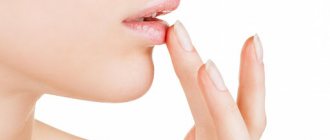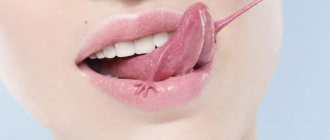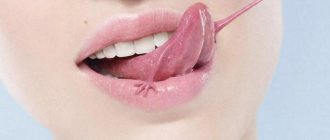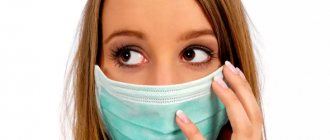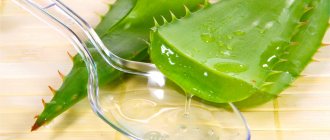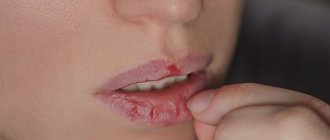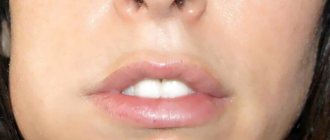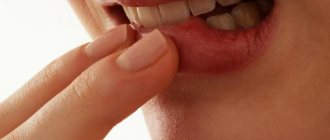Causes of cheilitis
The inflammatory process can begin for multiple reasons. One of the most common of them is mechanical injuries: for example, accidental biting can cause inflammation.
The development of the disease can also be provoked by:
- unfavorable environment (people who spend a lot of time outdoors and are exposed to wind, frost and other weather conditions are more likely to suffer from cheilitis);
- aggressive action of cosmetics or an allergic reaction to some of their components;
- lack of vitamin B2, which is responsible for the division and growth of epithelial cells;
- diseases of the gastrointestinal tract, liver, lack of immunity.
What should healthy lips look like?
Those who know how to moisturize their lips can boast of their naturally beautiful appearance. The natural red hue is due to the location of blood vessels near the surface.
Signs of healthy lips:
- smooth skin;
- smooth texture;
- pleasant natural shade;
- no peeling or cracking.
Healthy lips have even, uniform pigmentation without light or dark areas. Healthy skin looks elastic, it is not prone to irritation, peeling and allergies.
If a whitened area is detected, it means that the delicate skin does not receive enough hydration or there are not enough vitamins in the body:
- A,
- E,
- WITH.
First you need to learn how to use the right cosmetics. This applies to all people, because even if there are no problems with the lips, a careful attitude will not be superfluous.
You need to be able to choose the right cosmetics. And the first thing people pay attention to is the composition. Oil-based products should contain only natural ingredients:
- jojoba oil,
- cocoa,
- shi,
- nut oils.
It is best to buy products at a pharmacy or labeled “pharmacy product”. This means that cosmetics:
- passed dermatological tests,
- approved by experts
- considered safe.
In addition to moisturizers, there are small life hacks to improve the color and contour of your lips.
Shock freezing is often used: using ice to massage the lips. With prolonged exposure to cold, the appearance of the lips deteriorates, but short periods of exposure to shock cold cause the capillaries to expand sharply. Blood flows closer to the skin and provides:
- more active saturation with oxygen and nutrients,
- more saturated lip color.
The most common advice for lip care is the use of special lipstick. But there are several ways to moisturize your lips without chapstick.
Types of the disease, their symptoms
There are a large number of types of disease, each of which has its own symptoms. Cheilitis happens:
- catarrhal, resulting from injury. Its characteristic symptoms are redness, peeling, swelling and soreness of the lips.
- eczematous, developing due to the occurrence of eczematous processes. The reason is an allergy to a certain type of food, cosmetics (lipstick, cream).
- glandular, associated with an abnormality of the salivary glands. It happens that cheilitis on the lips accompanies periodontal disease, lupus, etc. The lower lip often suffers and begins to peel.
- meteorological. It is caused, as the name suggests, by weather conditions (high air humidity, strong wind, decreased or increased temperature, exposure to ultraviolet radiation, etc.).
- exfoliative, characterized by a chronic course. It is divided into two forms - dry (the blood supply to the lips is disrupted and, as a result, dry scales are formed, which can be easily removed, but after a few days they appear again) and exudative (the border swells and becomes inflamed, crusts appear).
- angular, called jam. Due to streptococci, inflammation begins in the corners of the lips. Vitamin deficiency and frequent licking of lips can also provoke it.
- atopic, accompanying atopic dermatitis. The red border of the lips flakes and itches, the lips crack.
- hypovitaminosis, which occurs due to a lack of B vitamins. Dryness and a pronounced burning sensation affect not only the lip area, but also the entire mucous membrane of the mouth, including the tongue. In this case, the mucous membrane turns red, and vertical cracks form in the area of the red border.
Regardless of the type of cheilitis, common symptoms will be:
- peeling of the lips, observed both only near the border and over the entire surface;
- swelling and swelling, burning and itching in the lips, the appearance of cracks and crusts on them.
Heilit (Zaeda)
Exfoliative cheilitis
It is a disease of the red border of the lips.
It is diagnosed mainly in women and is clinically manifested by peeling of the lips. The pathogenesis of exfoliative cheilitis includes neurological disorders - excitement, anxiety, depression. There is also a connection between the incidence of exfoliative cheilitis and hyperfunction of the thyroid gland. It has been proven that once it occurs, exfoliative cheilitis is inherited as a change in the immune system. Peeling is present only on the red border of the lips and does not spread to the mucous membrane and skin. The disease rarely spreads to the entire red border, so part of the red border in the area of the corners of the mouth and in areas bordering the skin remains free from peeling. If exfoliative cheilitis occurs against the background of dry skin, then in addition to peeling, patients note dry lips, burning, and sometimes the appearance of scales that are bitten or peeled off by hands. Exfoliative cheilitis has a long, sluggish course, with periods of remissions and exacerbations; not prone to self-healing.
During the examination, dry lips are revealed, the presence of scales tightly fused with the red border, due to which the edges of the red border look raised. Removal of the scales is usually painless; after their removal, a bright red surface without erosion is exposed. 5-7 days after removal, the scales appear again, fresh scales look like mica, and later they also adhere to the red border of the lips. With the exudative form of cheilitis, patients complain of soreness and swelling of the lips; Over time, large crusts appear, making speech and eating difficult.
Glandular cheilitis
The pathogenesis of glandular cheilitis involves congenital or acquired proliferation of the minor salivary glands, which contributes to their infection. In people with congenital anomalies of the minor salivary glands, symptoms of glandular cheilitis are observed in almost all cases. Patients with chronic periodontal diseases, tartar, and dental caries are at risk, since these diseases contribute to infection of the dilated ducts of the salivary glands.
Glandular cheilitis occurs both due to infection of the ducts of the salivary glands, and due to intoxication with toxins and waste products of microorganisms. Persons of both sexes suffer mainly after 30 years of age, while lesions of the lower lip are twice as common.
In the initial period of the disease, patients note slight dryness of the lips, which is compensated by lip care products and cracks that appear against the background of dryness. Subsequently, deep bleeding cracks and painful erosions form. Patients with grandular cheilitis tend to lick their lips, which further aggravates the symptoms of dryness, sometimes this leads to the appearance of weeping cracks against the background of dry and flaky skin of the lips. Later, the cracks are permanent due to impaired elasticity of the skin of the lips.
Contact allergic cheilitis
Occurs in response to exposure to a stimulus. The main causes of allergic cheilitis are substances that are part of lipsticks and lip care products. Allergic cheilitis can develop as a result of the bad habit of keeping foreign objects in the mouth: pens, pencils. Occupational allergic cheilitis develops in musicians in response to prolonged exposure to mouthpieces of wind instruments in the mouth.
Patients complain of severe itching, burning, swelling and redness of the lips. Moreover, after contact with an allergen, the symptoms of cheilitis are more pronounced. Sometimes the bubbles can be larger in size and after they are opened, cracks and erosions are exposed. When allergic contact cheilitis is chronic, the main clinical manifestations are peeling and slight itching without an inflammatory reaction.
Meteorological (actinic) cheilitis
It is part of a group of diseases whose pathogenesis involves hypersensitivity to cold, wind, solar radiation and radiation. Actinic cheilitis is more often diagnosed in men aged 20 to 60 years and often occurs in response to ultraviolet radiation. The survey determines general weather sensitivity, in particular sensitivity to solar radiation.
With the exudative form of cheilitis, patients complain of itching and burning of the lips, as well as the appearance of erosions and crusts. Sometimes, with meteorological cheilitis, small bubbles appear, after opening which painful erosions are exposed, which then dry out into crusts.
In the dry form of meteorological cheilitis, the main complaints are dryness and burning of the lips, and sometimes pain. In the case of a long course of actinic cheilitis, malignancy is possible; in the presence of factors such as smoking and dusty conditions in the room, the likelihood of malignancy increases. Often actinic cheilitis over time degenerates into precancerous diseases - limited hyperkeratosis, abrasive precancrosis cheilitis Manganotti, etc.
Atopic cheilitis
It is one of the manifestations of atopic dermatitis or neurodermatitis. An important pathogenetic link in atopic cheilitis is an allergic predisposition. In this case, allergens can be drugs, cosmetics, products, microorganisms and their toxins.
Patients with atopic cheilitis complain of redness of the lips, which is accompanied by itching and flaking of the red border of the lips, characteristically affecting the corners of the mouth. After the acute process subsides and during remissions, peeling and lichenification are noted. Constant dryness and infiltration of the corners of the mouth contributes to the appearance of cracks. Patients with atopic cheilitis have clinical manifestations of atopic dermatitis, neurodermatitis, dryness and flaking of the facial skin.
Macrocheilitis
Macrocheilitis is part of the Melkerson-Rossolimo-Rosenthal syndrome; the other components of the triad are facial neuritis and the folded tongue symptom. In the pathogenesis of this symptom complex, the infectious-allergic factor and hereditary predisposition are of great importance.
Patients complain of enlargement and itching of the lips, sometimes the swelling spreads to other parts of the face. Swelling with this type of cheilitis lasts indefinitely, sometimes a spontaneous improvement in well-being is possible, but after this a relapse occurs. The color of the lips and skin is not changed, although in places of swelling the skin is shiny and has a bluish-pink tint.
Usually one or both lips, cheeks, eyelids and other parts of the face in the area of innervation of the facial nerve are affected. In this case, neuritis of the facial nerve manifests itself in the form of a skewing of the face in the healthy direction, and the nasolabial fold is smoothed out. Because all three symptoms of the triad are not always present, diagnosing Melkersson–Rosenthal syndrome can be difficult.
Hypovitaminous cheilitis
It develops with a lack of B vitamins, with a particularly pronounced lack of vitamin B2. Patients complain of burning and dryness of the mucous membranes of the mouth, tongue and lips. During the examination, it is clear that the mucous membrane is slightly swollen, reddened, and on the red border of the lips there is fine scaly peeling and small vertical cracks against the background of dry and reddened skin of the lips. Cracks with hypovitaminous cheilitis are prone to bleeding and pain. Often, simultaneously with the development of cheilitis, changes are also observed in the tongue - it increases in size, and teeth marks become noticeable on it.
Cheilitis in children
Depending on the age of the child, he may experience a certain type of cheilitis.
Newborns suffer from a catarrhal disease caused by the prolonged presence of a pacifier or bottle in the mouth. Plus, saliva accumulates on the nipples of the lips, irritating sensitive baby skin.
If the disease is ignored, hoping that it will go away on its own, cheilitis will develop into an exfoliative form, accompanied by the formation of scales, which the child will not be able to remove himself (parents are highly discouraged from interfering in this process, since attempts to tear off the crusts can cause cracks, which will only aggravate the situation ).
Constant sucking of the mother's breast is an equally common cause of the development of the disease: during feeding, cracks form on the nipples, into which bacteria penetrate, which causes cheilitis.
Why do lips dry out?
Before looking for a way to quickly moisturize your lips, you should find out the cause of the problem. Depending on what formed the basis for the lack of moisture, you can choose a suitable remedy for complete restoration.
Causes of dry lips:
- Harmful environment. Cold, heat, windy weather and poor air quality. Cold and heat provoke a decrease in moisture in tissues. The condition worsens during strong winds.
- Stress. Situations when a person is very nervous and involuntarily licks his lips (a standard human reaction). The saliva that covers the delicate skin dries quickly, drying out the problem area.
- Medicines that affect the salivary glands, for example, drugs aimed at reducing appetite.
- Oral care products with high fluoride content. The element is characterized by a dehydrating effect. Thin skin is not able to retain moisture for a long time, as the dermis does on other parts of the body.
- Cosmetics: long-lasting lipsticks, matte formulations, tints and products with a dry/powdery effect. Pigments for artistic makeup. Powdering for better durability of conventional products speeds up drying.
- Unhealthy lifestyle: poor nutrition worsens the situation with vitamin saturation of the whole body. Lack of water (maintaining water balance is the key to health), alcohol, and tobacco are harmful.
- Diseases that cause dry mouth. These include allergic reactions, lip burns, dental diseases, inflammatory pathologies, bacterial and hormonal diseases.
Excessive dryness can be caused by a cold with a profuse runny nose and nasal congestion. With frequent inhalation and exhalation through the mouth, the lips become chapped and dry. During such a period, it is especially important to know how to keep your lips moisturized.
How can herpes be dangerous?
Herpes can cause many complications. Some of them are life-threatening.
- Bacterial complications. Most often, bacteria simply attach to the virus and the blisters fill with pus. If the blisters have already burst, then the ulcers become covered with pus, the pain in the lip becomes unbearable and a crust does not form.
- Herpetic stomatitis is a lesion of the oral mucosa. The disease begins with a sharp increase in temperature, salivation and sharp pain when chewing food. There are many blisters in the mouth, similar to herpes on the lips.
- Herpetic eye damage begins with pain in the eyes and lacrimation. A person cannot open his eyes due to severe pain. A dangerous condition that can result in blindness.
- Herpes of the esophagus. Occurs when herpes spreads from the lips. There are difficulties when swallowing, severe pain, refusal to eat and weight loss.
- Herpetic pneumonia and herpetic hepatitis occur in people with immunodeficiency and occur together with bacterial and fungal processes.
- Herpetic damage to the nervous system occurs in the form of meningoencephalitis and is the most severe form of herpes. It begins with a sharp headache, nausea and vomiting, high fever, movement disorders and convulsions. The disease is unfavorable.
Photo: To avoid complications, you need to start treating herpes in a timely manner.
